Are you thinking about building a distributed team? Or are you trying to convince your boss or company of the opportunities in doing so?
Maybe you're starting up something new and the flexibility and freedom of being fully remote are attractive.
Maybe an employee just told you they're moving out of state for family reasons and they want to stay with the company.
You've heard a bit about the benefits of remote work– not just for employees but for companies too– and now you're thinking, "Should I go distributed? Should I hire remote employees?”
We might be a bit biased here at Lighthouse, as our team is fully distributed, but the truth is there's more to the rise of remote work than just the development of new technology.
Distributed teams have several advantages over co-located teams that are worth considering. These advantages are being taken advantage of by more companies than ever before.
The rise of distributed teams
It's impossible not to notice the rise of remote work over the past several years.
The number of companies with distributed teams has exploded in less than a decade (nearly 10x faster than the rest of the workforce), from a few outliers to several hundred.
Just look at this list from Auth0 engineer Artu Klajnerok:
Biggest distributed companies by employee 🌎@mozilla > 2000@elastic > 1800@InVisionApp > 1300@gitlab > 1000@automattic > 950@digitalocean > 600@auth0 > 560@CloudBees > 500@zapier > 260@CircleCI > 250@Percona > 190@xteam > 180@dribbble > 170@buffer > 140
— Artur Klajnerok (@artur_sfo) November 30, 2019
Who else?
After posting, he was bombarded with more companies:
Building remote-friendly companies list here, let me know who to add nexthttps://t.co/4utfSQHuX1
— Artur Klajnerok (@artur_sfo) November 30, 2019
The list grew so much that he ended up creating a Twitter list to organize the ever-growing list of remote-friendly companies here.
We've talked before about how different managing distributed teams is.
Distributed teams = In-person teams
Remote work is different from working on-location. Managing distributed teams has its own set of challenges, such as:
- Time zone differences
- Communication hurdles
- And less of a natural social support structure for remote workers
However, distributed teams have some big positives as well, which we'll cover today.
By using the greatest of these benefits as a selling point, you'll be a lot more likely to convince your company to build its first distributed team.

Table of Contents -
Why You Should Start Building Distributed Teams
And when you take the plunge, here's what to do:
Why You Should Start Building Distributed Teams (+ how to convince your company)
There are a lot of reasons to consider building a distributed team and taking on your first remote employees.
However, there are a few benefits that far outweigh the rest and make going at least partly distributed worth considering for many companies.
In fact, it's already happening quite often. According to Condeco's Modern Workplace report, 43% of US employers say they plan to offer their employees more remote working opportunities over the next year.
Here's why you should start building distributed teams:
You already said talent pool, but simply put: you can hire the best person for the job within 25 miles of the office OR the best person for the job in the entire world. Your choice.
— Ben Bradley (@benjbradley) December 19, 2019
1) Tap into a larger recruiting pool
Working out of an office isn't ideal for a lot of people, whether it's due to having small children, elderly parents, a personal condition that makes frequent travel difficult, or something else.
This makes the rise of remote work a blessing, not just for them but for you as you search for the most ideal candidate.
However, it's more than just being able to tap into those specifically remote candidates you otherwise wouldn't have access to. Instead of only being able to hire near you, as a distributed team you can hire anywhere.
For example, if you were looking for a Senior Software Engineer in the San Francisco Bay area, running a search on LinkedIn you'd get about 250,000 results:

If you widen the search to include the entire U.S., you get nearly 8x that:

Including the entire U.S. is a bit of an extreme example (LinkedIn doesn't let you search by state), but it goes to show your potential recruiting pool can be substantially bigger if you open it up to a larger area, even if simply your extended county or state.
But does that mean more applicants?
Clearly, your recruiting pool is much larger if you're hiring for a remote position.
However, does that mean you'll get more applicants to your job?
Remote OK job board founder @levels.io did some number crunching based on their average number of applicants. He found that the typical job post received about 47 clicks to submit an application, while the top 5% postings received about 263:

He's quick to point out, though, that most companies post the same opening on several job boards. Assuming the average remote job is posted on just 3 job boards, and only 50% who click to submit an application actually do submit, that would be at least 75 applications.
Compared to the average 57 applications a typical job posting receives, that's over 30% more applicants on the low end.
The data behind those numbers could be stronger, but it's not the only proof of the huge number of applicants companies are getting for their remote job openings.
Basecamp recently got over 700 applications for their recent Head of Marketing (remote) position:
Out of the 700+ applications we’ve received for our Head of Marketing position, 200 came in today - the last day we’re accepting applications. Just a few hours left to stand out! There’s no penalty for procrastination, but the deadline is real. https://t.co/jZdPadueVX
— Jason Fried (@jasonfried) June 28, 2019
But he's Twitter famous, so that skewed it, right? Not quite. A quick search found that Beyond Type 1 received a record number of applications for its remote position:
HIRING UPDATE: We received a record number of incredibly qualified applicants for the Remote Project Manager position.
— Beyond Type 1 (@BeyondType1) June 21, 2017
And Dynamite Jobs broke their recent record with over 400 applicants for a single remote job post:
We've just hit a record 400 applicants for a job we've posted over at https://t.co/NGCbpPfMew Pumped to be helping great companies find exceptional remote talent
— Ian (@AnythingIan) November 22, 2019
How wide should you cast your net?
When thinking about how far you should cast your net, consider the importance of the hire being in the same or similar time zone.
Be smart about it. You want your first hire to be in a similar time zone so communication is easy as you get used to distributed working.
Hiring your first distributed team members is likely an experiment and you want it to succeed. Unfortunately, if your first hire fails, then it could have a chilling effect on your company being willing to hire more distributed teams.
If you're not sure how far to take your search try this: start small, in your same county/state, first, that way all your candidates will be in the same time zone.
If you don't find who you're looking for, consider extending your net to adjacent states in the same time zone (for example, all of California, Washington, Oregon, and Nevada if you're in SF).
Even if you need to extend beyond that to Central or Western-Eastern time, that's still just a two-three-hour difference and more than workable.
Depending on their proximity to airports, it could make a flight to visit both short and economical. For example, flights to SFO from these locations are all short enough to be a day trip to visit: (times courtesy travelmath.com)
- LA: 57 minutes
- Las Vegas: 1 hour 9 minutes
- Portland: 1 hour 24 minutes
- Phoenix: 1 hour 40 minutes
- Seattle: 1 hour 43 minutes
- Denver: 2 hours 11 minutes
The real issue is when a team member is halfway around the globe and going to sleep when you're getting in the office and vice versa. So maybe hold off on that Ukrainian engineer, marketer in Malaysia, or Australian designer until you're more comfortable with remote work.
Finding the right person should be the priority, but if you can find the right person in the same or similar time zone, it will make a big difference when managing them, especially if it's your first time managing a distributed team.
2) Save money
One of the least talked about benefits of hiring remote is the potential savings.
With the cost of living being different (i.e.- significantly lower) in different states and cities, you can hire some of your people for cheaper than if you were in an ultra-expensive area like SF, NY, Boston, etc.
For example, the cost of living in Boise, Idaho, one of the fastest-growing cities in the U.S., is 50% less expensive to live in than San Francisco.
If you were hiring a Senior Software Engineer in Boise, paying them a $75,000 salary would match the standard living that $150,000 would get them in SF, which is quite the savings for you!:

How could this be? No surprise, that's mainly due to the crazy housing costs in SF, which is nearly 4 times lower in Boise, whether you're renting or buying:

Similarly, comparing a different ultra-expensive locale, New York City, to another affordable and fast-growing city, Tulsa, Oklahoma, would net you similar savings.
Compared to various parts of NYC, from Queens to Manhattan, the cost of living in Tulsa is 45-65% lower, which would net you similar savings or more.
Also, instead of spending $10,000 or more to relocate someone to the main office upon hiring, you can spend a fraction of that on some flights for them to go to the office a few times a year for important meetings, getting you even more savings.
Should you pay everyone equally?
Hiring employees who happen to live in less expensive areas can net you big savings, but what if you're not comfortable paying differently based on their cost of living?
Buffer previously announced salary changes so that everyone would receive the same pay no matter their local cost of living.
However, if you do that, you risk overpaying employees and making them too loyal. If they're being massively overpaid compared to their area, they'll be desperate to stay because they won't want to take such a big pay cut to go anywhere else.
If that's the case, they may be less likely to give honest feedback and bring up issues when they arise out of fear of what might happen to them. They also may stick around a job they're unhappy with, again because the money is too good to walk away from.
Previously Buffer used a formula based on cost of living data to adjust compensation up or down based on the differences. They use data from Numbeo and then place them into one of four levels: 100%, 90%, 85%, or 75% based on their cost of living:
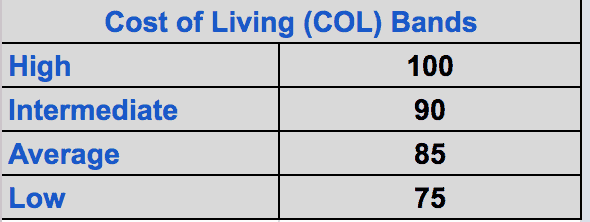
For example, if an employee's cost of living is average, they receive 85% of the compensation designated as in the 50th percentile in San Francisco. In other words, the amount they'd get is based on SF's high cost of living.
So, if they'd receive $150,000 as a Senior Engineer in SF, at an 85% level they'd receive $127,500 with Buffer's formula:
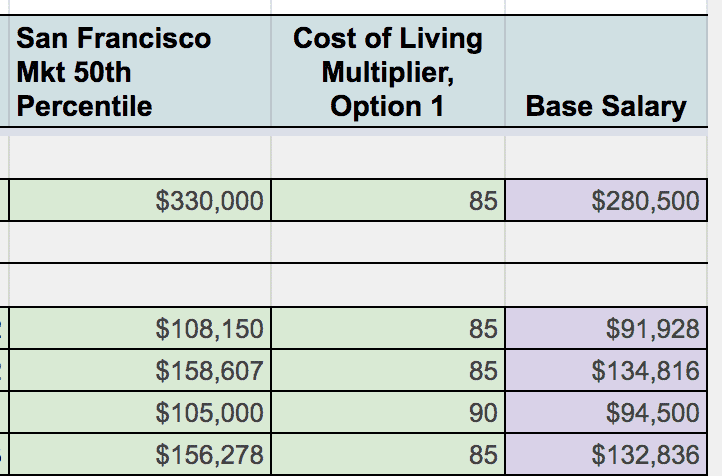
Ultimately, the choice is up to you and your company how to handle compensation. However, the potential savings you can take advantage of from hiring remotely can be quite significant.
If you need to sway someone that thinks mostly in "dollars and cents" this could be key to convincing them.
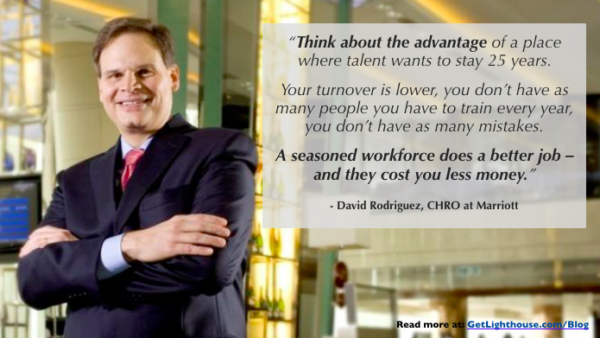
3) Boost retention
Sometimes, you lose good people because they need to move away. They may want to move somewhere they can afford a home, be closer to family, or their spouse may get a job elsewhere.
If you open the door to remote work, those people can still work for you, potentially saving you from losing a key employee.
Whether it's a personal medical issue, a family matter, or something else, allowing employees the flexibility to go remote can help retain key employees who would otherwise need to leave. Best of all, this retention has its own savings attached to it when you consider the cost of recruiting, interviewing, and hiring someone to fill their shoes.
Also worth noting, this flexibility is the second most sought-after job perk, according to Mary Meeker's Internet Trends Report:
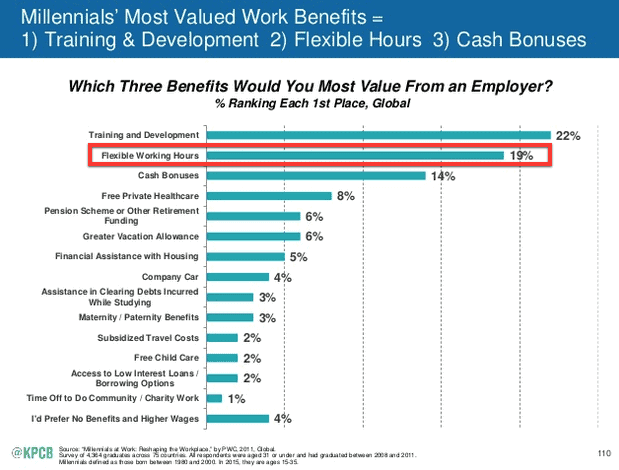
This perk doesn't have to be reserved only for employees who need to move away, though.
You can do the same for your office workers, too.
You could also potentially offer your office workers a similar option.
For example, you could give them a day from the office to work remotely, away from the distractions and interruptions of the office. This can be especially useful for creatives like software engineers and designers.
I'm located in NYC now and I've seen some great examples of this.
In one common case, the father of a growing family moved further out of the city so they could afford the home and lifestyle they wanted. When his employer allowed them to work from home twice a week, they're still able to make all the needed meetings each week while saving four hours each week on commutes.
In another case, I learned that Amtrak is super convenient in the Northeast corridor. A woman I met moved to Philadelphia to be closer to her family, but was able to keep her design job in NYC.
She now commutes at least one or two times a month for face time and team bonding. Meanwhile, she takes longer trips when her team has key planning meetings and major initiatives are kicking off. Because the train ride is so short (about 90 minutes), it's not a big deal for her to take a day trip, and doesn't cost her company much (tickets as low as $61 each way).
In both cases, these accommodations have allowed employees to have the best of both worlds: having more time with their families while keeping their positions at their current jobs.
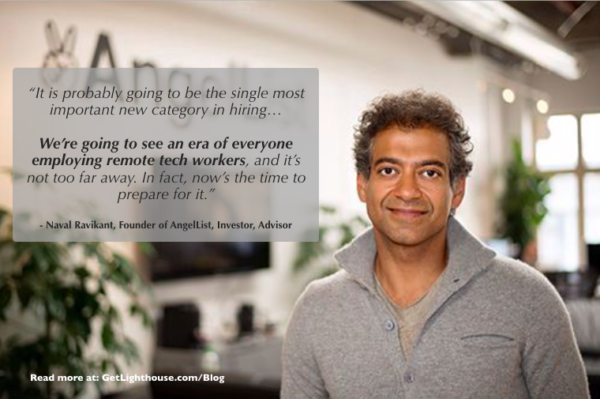
Distributed teams are the future - are you ready?
Distributed teams have their own set of challenges, especially because managing remote employees is so different from managing those on-location with you.
You might be a seasoned manager, but managing a distributed team will surprise you with challenges you've likely never have faced before (and may not see coming).
Still, remote work has far more positives– and big ones– not only for employees but for your company as well.
This is why it's an unavoidable trend. You might as well take advantage of it now, or miss out.
Remote in all its forms is growing.
An estimated 70% of the U.S. workforce will work remotely at least five days per month by 2025, according to Global Workplace Analytics.
The sooner you start building distributed teams, or opening your existing teams up to partially remote work, the better prepared you will be for the inevitable transition of remote becoming the norm.
And once you hire those new remote employees, you need to do a good job with them, so start with these posts on hiring and managing remote employees:
- First, check out this guide to learn everything you need to know before you start hiring remote: 12 Things You Didn't Plan for When You Started Hiring Remote Employees
- And learn more about the challenges of managing distributed teams: The 5 Major Pitfalls of Managing a Partially Remote Team
- Plus: 5 Common Mistakes Managers Make with Remote Workers
- Lastly, check out these posts to learn more about how you can build rapport with and better support your remote employees:
Are you growing as a leader? Are you building the skills you need?
Whether your team is in office with you or remote, Lighthouse Lessons can teach you the skills you need to better lead, motivate, and grow your team. Let us help you navigate the unique challenges of being a leader like we helped Daniel by learning more and signing up here.





